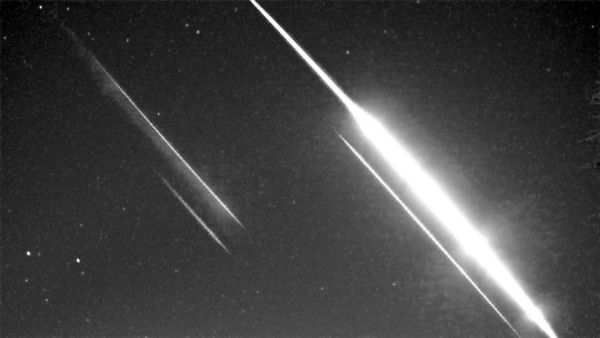Massive fireball scattered loads of meteorites across southern Ontario
Western University and the Royal Ontario Museum are asking for Ontarians to report "suspicious rocks."

If you live in Ontario, keep your eyes peeled for "suspicious rocks."
On Sunday (April 17), skywatching cameras in the Canadian province recorded a massive fireball that likely produced tens to hundreds of grams of meteorites. Astronomers predict they would have fallen on the eastern shore of Lake Simcoe, north of the town of Argyle.
"This fireball was particularly significant because it was moving slowly, was on an asteroidal orbit, and ended very low in the atmosphere. These are all good indicators that material survived," Denis Vida, an astronomy postdoctoral associate at Western University who specializes in meteors, said in a university statement.
Related: Rare meteorite, a 'relic of the early solar system,' falls on a driveway in England
More than a dozen all-sky cameras of Western's Southern Ontario Meteor Network (SOMN) recorded the event, which occurred at 11:37 p.m. EDT local time (0337 GMT on April 18). Cameras belonging to the Global Meteor Network (GMN), which are operated by citizen scientists, also captured the meteor.
Astronomers have used the footage to determine that the fireball became visible at an altitude of around 60 miles (90 kilometers), traveled due north at a sharp angle just 30 degrees from vertical, and continued to burn as low as 18 miles (23 km) in altitude. "Taken together, these factors suggest many small meteorites have made it to the ground," said Vida.
As such, Western University and the Royal Ontario Museum are asking residents in the area of the suspected meteorite fall zone to report any "suspicious rocks" they may find by sending an email to naturalhistory@rom.on.ca. (Worth noting — in Canada, meteorites technically belong to the owner of the land on which they fall.)
Get the world’s most fascinating discoveries delivered straight to your inbox.
Meteorites typically have a dark color and a scalloped texture, and they are also quite dense. If you find one, store it in a plastic bag or wrap it in aluminum foil — the meteorite itself poses no danger to humans, but scientists prefer to keep them as uncontaminated as possible.
"Meteorites are of great interest to researchers as studying them helps us to understand the formation and evolution of the solar system," Vida said.
Follow Stefanie Waldek on Twitter @StefanieWaldek. Follow us on Twitter @Spacedotcom and on Facebook.

Space.com contributing writer Stefanie Waldek is a self-taught space nerd and aviation geek who is passionate about all things spaceflight and astronomy. With a background in travel and design journalism, as well as a Bachelor of Arts degree from New York University, she specializes in the budding space tourism industry and Earth-based astrotourism. In her free time, you can find her watching rocket launches or looking up at the stars, wondering what is out there. Learn more about her work at www.stefaniewaldek.com.



